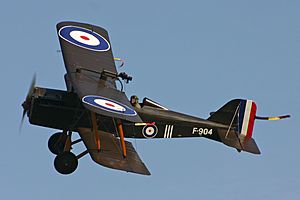Charles Pickthorn facts for kids
Quick facts for kids
Charles Edward Murray Pickthorn
|
|
|---|---|
| Born | 20 September 1896 Ilford, Essex, England |
| Died | 3 March 1938 (aged 41) Orford, Suffolk, England |
| Allegiance | United Kingdom |
| Service/ |
British Army Royal Air Force |
| Years of service | 1915–1920 |
| Rank | Major |
| Unit | No. 8 Squadron RFC No. 32 Squadron RFC |
| Commands held | No. 84 Squadron RAF |
| Battles/wars | World War I • Western Front |
| Awards | Military Cross Medal of Merit, 2nd class (Chile) |
| Relations | Kenneth Pickthorn (brother) |
Major Charles Edward Murray Pickthorn (born September 20, 1896 – died March 3, 1938) was a brave British World War I pilot. He was known as a "flying ace" because he shot down five enemy aircraft. One of his most famous victories led to the capture of Prince Friedrich Karl of Prussia.
Contents
Early Life and Family
Charles Pickthorn was born in Ilford, Essex, England. He was the second son of Charles Wright Pickthorn and Edith Maud Berkeley Murray. He went to school at Aldenham School in Hertfordshire. His older brother was Sir Kenneth William Murray Pickthorn, who later became a well-known politician.
Flying High in World War I
Charles Pickthorn joined the British Army in 1915. He first served in the Army Service Corps. But soon, his love for flying led him to the Royal Flying Corps, which was the early version of the Royal Air Force.
Starting as an Observer
In June 1916, Charles became an observer and gunner. He flew in a two-seater plane called the B.E.2c. This plane was used for scouting and light bombing missions. Once, his pilot was badly hurt during a fight. Charles bravely took control of the plane and flew them safely back to base. He even sent a Morse code message for help! For his courage, he was recognized by Sir Douglas Haig, a top British commander.
Becoming a Fighter Pilot
After his time as an observer, Charles trained to become a pilot himself. In late 1916, he joined No. 32 Squadron. Here, he flew a single-seat fighter plane called the Airco DH.2. This is where he started to become a flying ace.
First Victories in the Sky
Charles got his first aerial victory on January 27, 1917. He worked with other pilots to destroy an enemy reconnaissance plane. A month later, he forced another enemy plane down. On March 6, he destroyed an Albatros D.I plane, but he was also wounded in this fight.
The Prince and the Plane
On March 21, 1917, Charles had his most famous victory. He was flying his DH.2 when he spotted an Albatros D.I fighter plane. This enemy plane had a scary skull and crossbones symbol painted on it. Charles forced the plane down behind British lines. The pilot tried to escape but was shot and captured by Australian soldiers. This pilot turned out to be Prince Friedrich Karl of Prussia, a German prince. Sadly, the prince died from his wounds two weeks later.
Awarded for Bravery
For his amazing bravery and skill, Charles Pickthorn was given the Military Cross. This special award recognized his "conspicuous gallantry and devotion to duty." The award mentioned how he attacked enemy aircraft and flew difficult scouting missions. It also highlighted how he continued to fight even after being wounded, bringing down enemy planes.
Leading a Squadron
As Charles gained more experience, he was promoted. By early 1918, he became a temporary major. On November 8, 1918, just before the war ended, he took command of No. 84 Squadron.
Last Victory of the War
On November 10, 1918, Charles flew a Royal Aircraft Factory SE.5a plane. He destroyed a Fokker D.VII enemy plane. The very next day, November 11, the war officially ended with the armistice. Charles's S.E.5a plane, with the serial number F904, is now part of a special collection called the Shuttleworth Collection. It can still fly today!
Life After the War
After World War I, Charles Pickthorn continued to serve for a short time. He was part of the British forces in Germany. In 1919, he left the Royal Air Force.
Flying in Chile
In 1920, Charles went to Chile. He worked there as a flying instructor for the Chilean Military Aviation Service. He helped train new pilots. For his work, he received the Chilean Medal of Merit in 1925.
Continuing His Aviation Career
Charles remained involved in aviation. He joined the Reserve of Air Force Officers. He was promoted to flight lieutenant and later allowed to keep the rank of squadron leader.
In 1928, he became a member of the Royal Aero Club. He also took part in a special race for flying instructors, showing off his skills. Later that year, Charles helped start the Brooklands School of Flying. He worked there as a flying instructor. He even competed in the King's Cup air race in 1930, flying a Gipsy Moth plane.
Charles Edward Murray Pickthorn passed away in March 1938.
Personal Life
Charles Pickthorn was married twice. His first marriage was to Bessie Dorothy Batten Bell in 1917. Later, in 1932, he married Hilda Pyper. They had a daughter named Catherine, who was born in 1936.
Images for kids



